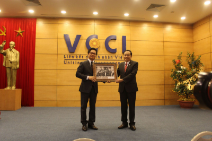Wood businesses implement digital transformation
Digital transformation is a trend chosen by wood enterprises to increase production efficiency. However, each business is a story of its own, it needs its own solutions, and digital transformation is a long process that businesses need to have a plan and appropriate resource allocation for each stage to achieve effective results.
 |
|
High-quality personnel is the weakness of wood enterprises when implementing digital transformation. Photo: TL |
Difficulty in personnel
The "Report on the situation of digital transformation of the wood industry 2022" conducted by Novaon Tech, the Vietnam Internet Association with the participation of the Handicraft and Woodworking Association of Ho Chi Minh City (HAWA), shows that up to 75% of enterprises evaluate that digital transformation will be a strong influence on the core competitiveness of enterprises in the next one to five years.
During the two years of the pandemic, digital transformation helped wood businesses reduce costs by 10%, while revenue grew by 10-20% and labor productivity increased by more than 20%.
However, the level of digital transformation of Vietnam's wood industry is at a low level. The report shows that 20% of businesses have yet to digitally convert any item, more than 56% of businesses have only partially converted and only 4.2% of businesses have digitally converted the entire operation process.
There are three reasons for this situation, which is the high initial cost; technology capacity and human resources have not yet met digital transformation and businesses lack professional partners, capable of consulting and providing good solutions.
Specifically, up to 82.5% of businesses are concerned about the initial cost being too high; 80% of enterprises lack professional partners with good consulting capacity and solutions with high competitiveness. Besides, 65% of enterprises face difficulties in skills, technology capacity and human resources.
In addition, in the process of digital transformation, wood industry enterprises also face difficulties such as leaders who do not have the desire to implement digital transformation, business strategies that have not set digital transformation as a priority, and there are too many customers.
With 30 years of experience in supplying machinery and equipment in the wood processing industry, Mr. Le Duc Hieu, Project Manager of Vi Dai Trading Company Limited (VETTA), assessed Vietnamese wood processing enterprises as not inferior to other countries in the region in terms of investment in single machinery. However, compared with large enterprises in the region and European enterprises, they lack the connection between single machines to be able to operate smart production lines.
Mr. Hieu pointed out that the problem of most wood processing enterprises in digital transformation today lies in human resources. “After decades of development and accumulation, Vietnamese wood enterprises have enough financial capacity to invest and buy modern machinery from Europe and accompanying software for smart production. However, not all enterprises have high-quality human resources to operate that smart chain," said Mr. Hieu.
Accordingly, out of ten businesses that buy machinery and equipment with accompanying software, only three can operate smart production lines. While the cost for the lowest investment in smart production software is VND3 billion, the package software can be up to VND10 billion. But according to Mr. Hieu, there are businesses that invest VND10 billion to buy machinery and software but cannot operate because of a lack of human resources.
Building on-site team
Mr. Nguyen Chanh Phuong, Vice President of HAWA, said that in the past, HAWA has communicated to businesses to understand where digital transformation begins and now HAWA has moved to the next step of making this journey.
Specifically, HAWA has started by building awareness among business leaders as well as building a group of CIOs (directors of information technology) to narrow the gap between business leaders and those performing the work of digital transformation. At the current stage, HAWA is introducing specific solutions for businesses with appropriate costs.
According to Mr. Nguyen Chanh Phuong, digital transformation depends on the vision and thinking of enterprises, there is no best solution, covering all businesses but only suitable solutions for the business group or just a specific enterprise.
The same is digital transformation, but businesses should not be mechanical and modeled after other businesses because they will not create different values but also unintentionally put pressure on each other to compete.
As a manufacturer and exporter of interior and exterior furniture for major brands and distribution systems in Europe and America, Scansia Pacific Company started digital transformation 10 years ago.
Mr. Nguyen Hoai Bao, Vice President of Scansia Pacific shared that in order to transform digitally, enterprises must first standardize internal processes and then choose software solutions from external units. At this time, the difficulty lies in the fact that the software suppliers do not understand much about production and vice versa, the production staff do not have software expertise, so the interaction and exchange are limit ed.
Overcoming this difficulty, Scansia Pacific has built its own software development team and this works very well when it is able to quickly review and solve problems of enterprises.
Mr. Nguyen Hoai Bao shared the great benefits that Scansia Pacific has received thanks to digital transformation. “Anywhere, business leaders can open their phones to view reports, open applications on their phones to see the production situation every hour, every minute, where the goods are being produced. This is a great liberation for business leaders,” said Mr. Bao.
Mr. Bernd Kahnert, CEO of GCC Consultancy Co., Ltd. recommended that businesses should not be too greedy when implementing digital transformation but should do it step by step. "This is not a short-distance race, but a long-term marathon," said Bernd Kahnert.
Accordingly, businesses need to have the appropriate calculation and allocation of resources for each period to bring the highest benefits.








